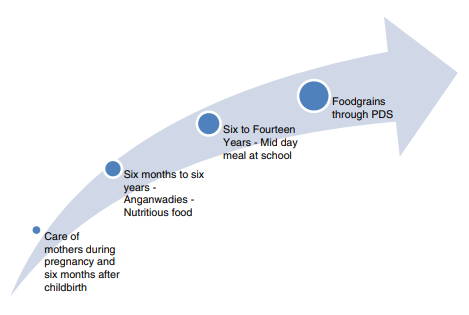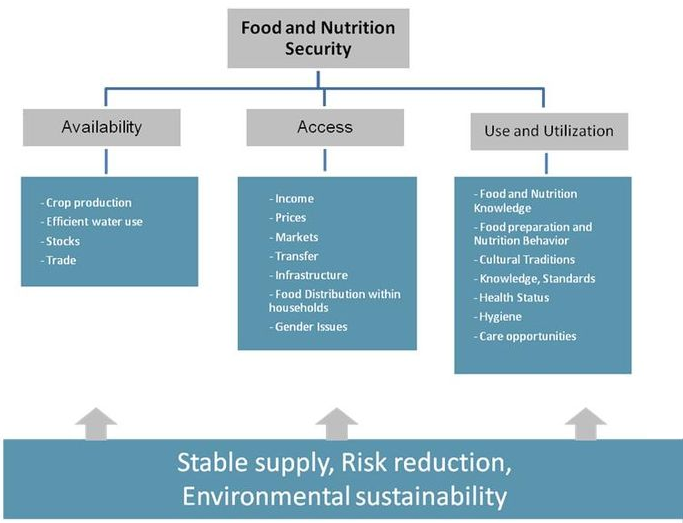Dimensions of Food Security | 30 May 2020
This editorial is based on “It’s about food, nutrition and livelihood security”, which was published in The Hindu on 05/05/2020. It talks about the importance of different dimensions of food security to tackle the COVID-19 pandemic
The current national lockdown imposed by the government to tackle the Covid-19 pandemic has highlighted the many problems pertaining to food, nutrition and livelihood security, confronted by a large number of people, particularly in rural areas and migrant labourers (who are reverse migrating from the cities).
Food security in a broader context exists with universal physical, social and economic access to sufficient, safe and nutritious food to meet their dietary needs and food preferences for an active and healthy life.
Though various measures have been announced by the Government under the Pradhan Mantri Garib Kalyan Yojana, it is important to recognise the different dimensions of food security in a holistic manner in order to address this problem in its totality.
Various Dimensions of Food Security
- Availability of food: Self-sufficiency in the production of food is a crucial aspect of sustainable availability of food.
- With the great accomplishment of Indian farmers and policymakers, due to the Green Revolution, today India has become self-sufficient in food production.
- This has converted a ship to mouth situation (where India had to rely on the United States for food supply under Public Law 480 (PL-480)) to a “right to food” commitment.
- Access to food: It largely depends on the purchasing power of the consumer. However, through the National Food Security Act (NFSA) and the PDS, the government assures the food requirement of the poor section of society.
- Absorption of food in the body or its utilisation: It depends on sanitation, drinking water and other socio-economic aspects of a household, determined by knowledge and habits.
- The utilisation of these services is dependent on the capacities of the Panchayati Raj Institutions (PRI’s) and their coordination with other local bodies.
- Stability: Apart from above-mentioned dimensions of food security, the temporal dimension of food and nutrition security, is also very important.
- It ensures the year-round supply of food, income and economic resources to household-level.
- Furthermore, it is important to minimize external risks such as natural disaster and climate change, price volatility, conflicts or epidemics.
Issues Involved
The Covid-19 pandemic crisis has threatened every dimension of food security, therefore, it is very crucial to understand the linkages between agriculture, nutrition and health.
- Agricultural distress: Farmers are confronted with various challenges like:
- Labour shortages
- Expensive agricultural inputs like seeds and fertilizers
- Inefficient marketing arrangements
- Non-remunerative pricing and inadequate public procurement
- Job security: Food security and access to nutritious, good quality food are also contingent on job security. Today, a lot of people employed both on farms and in the non-farm sector are without jobs.
- If job security is threatened, then so is food and nutrition security.
- Hidden hunger: In light of the closure of schools and Anganwadi centres, and the consequent disruptions in the provision of midday meals or other nutritional inputs may increase the cases of hidden hunger.
- It is important to pay attention to the life cycle approach advocated in the NFSA, particularly the first thousand days in a child’s life when the cognitive abilities of the child are shaped. Otherwise, there may be negative effects on nutritional security in the medium to longer term.
- Basic amenities: The lack of adequate clean water, in particular, has come to the fore in both rural areas and urban slums in the context of COVID-19, where one of the key measures for stopping transmission relates to frequent hand-washing.
Life Cycle Approach
- National Food Security Act 2013 (NFSA) is a unique step taken by the Indian government to fight against hunger and protect the rights of the people for food. In the life cycle approach, the care of the person taken by the government considering the nutritional requirements throughout the life cycle.

Life cycle approach of NFSA
Hidden Hunger
- Hidden hunger is a lack of vitamins and minerals. Hidden hunger occurs when the quality of food people eat does not meet the nutrient requirements, so the food is deficient in micronutrients such as the vitamins and minerals that are needed for their growth and development.
Steps To Be Taken
- Expansion of food basket: The PDS should be strengthened and the food basket can be enlarged to include millets, pulses and oil. This may certainly help in addressing the issue of hidden hunger
- Job creation: Attention needs to be given to the horticulture sector on a priority basis. Women farmers are at the forefront of horticulture and special attention needs to be given to both their technological and economic empowerment during this crisis. One way of doing this is by promoting food processing industries. For Example:
- The Amul model provides a good example from the dairy sector of improved incomes to milk producers through value addition
- The Rice Biopark in Myanmar, wherein the straw, bran, and the entire biomass are utilised.
- Livelihood security: A livelihood security for small and marginal farmers and landless households, and women within them, can be ensured by strengthening the Mahatma Gandhi National Rural Employment Guarantee Act (MGNREGA).
- Due to the loss of jobs and incomes during the COVID-19 crisis, it is imperative to expand the definition of work in MGNREGA to cover skilled work related to farmers and their farming activities.
Conclusion
Right to food is not only a statutory right but also a human right. However, due to the disruption caused by Covid-19, there is a need to incorporate a broader definition of food security. This will help in addressing the hunger of millions and achieving sustainable development goals.
|
Drishti Mains Question Discuss the various dimensions of food security, highlighting its linkages with agriculture, nutrition and health? (250 words) |
This editorial is based on “The end of autonomy for Hong Kong” which was published in The Hindustan Times on May 29th, 2020. Now watch this on our Youtube channel.

